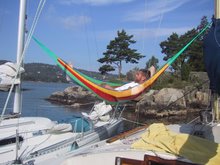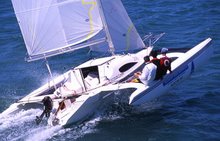In order to participate in any of the serious races the boat need to comply with the ISAF safety regulations. Those are pretty comprehensive regulations. I do really regret that I did not pay more attention to those during the building, as it would have done everything much easier.
Here is some of the stuff I am currently weighing the boat down with.
Fluorescent anti fouling for the daggerboard to make a highly visible area if inverted. Not available in Norway but thanks to mr Guy Waites I had it shipped from the UK.
As the weather was continous too cold for any epoxy work, I pulled the boat out of the barn during Easter to go to Silas' work where he was also fitting out his C-24.
Major tasks when indoor was to get all the exterior epoxywork done. I did not of course (things always takes a lot longer than you think) but I managed to do some.
Horn cleat for tiller-engine link was attached in epoxy reinforced holes
Hull was cut back a few cm to allow the engine to turn to port. Dug out foam core.
Filled with high density epoxy filler
Attachments for autopilot ST-2000+. Oversized holes were made and the tiller pin and the mounting socket were bedded in high density epoxy filler in the correct height.
Hole for electrical connection in cockpit. Dug out foam and backfilled the edge.
Testfitting the tillerpilot. May be hard to control from cockpit, might be adequate. If not I will have to add a remote.
Holes in main bulkhead and coamings for instruments, chart plotter, sheet cleats and cleats for barberhaulers. Dug out foam and backfilled with HD epoxy.
A picture taken much later showing the instruments and cleats.
Then I blew a head gasket on my commuting tool. Picked down and rebuilt the engine much faster this time.
Holding tank. I make a holding tank, approximately 30 liters, as a combined tank and support for the RM 69 ABS toilet. This inside finish of the tank would make my car re building neighbours drewl.
Tank top just before fitting
Holding tank/toilet support finished. To the left venting connection and to the right a tube will extend to the bottom of the tank and serve as in and out trough the three way valve and pump on the toilet. Studs for attaching the toilet.
The daggerboard got it's fluorescent anti foul. It was difficult to apply this with a good finish. I ended up rolling twice, wet sanding between layers and as a finish. Was able to keep the finish very fine this way.
Daggerboard now back in the boat. Mast step and daggerboard control lines re mounted.
I added hinges and small supports /flanges to the cutouts in the settees. On port covering the head, on starboard just to make access to the storage under the V-berth easier.
Head compartment with hatch open. Unfortunately I miscalculated the placement of the head a bit so it touches the hull with the bowl. Will add a 6mm UHMWPE sheet between head and tank top.
Head in closed position.
Added an anti slip pattern wear strip from anodized aluminium to the main entrance.
This picture shows how I was just able to squeeze the jib traveller between the mast step and the daggerboard. No room wasted. Will not be able to tack with board up, something I do not plan to do anyways. Colligo marine soft snatch blocks used to bring halyards to winches. Attached to Colligo soft padeyes.
2:1 self tacking jib sheets. This system allows the sheets to stay connected to the jib also when furled, and sheeting can be done from any side from cockpit. Barberhauler added on port side, to allow backing the jib besides trimming at deeper angles.
Jib sheeting set up. Turning blocks attached to Colligo soft padeyes that doubles as lifting eyes.
Compass was added to pop top earlier. 35W solar panel added to top side. Planing to purchase a MPPT controller from Genasun.
I had a lot of problems attaching and detaching the screacher furler last year. Will not leave the screacher out when not sailing, so had to either make a tack line of some sort, which would use some space under the furler, or make the bow pole deck operated. Opted for the latter, and the lashing line for the water stay is now dead ended at a small horn cleat at the root of the sprit.
Detail of horn cleat. Easily operated from the front deck. Bow pole can then be swung up, and furler attached / detached.
Battery secured on it's holder just under forward end of cockpit floor.
I will try to update more often as I am getting ready for launch. That should not be too long now, althoug cold and foul weather makes progress very difficult at times.



































3 comments:
Fantastic!
Looking forward to hearing of your sailing experiences after all these modifications.
Bravo!
Looking good & VERY interesting.
Silas put me onto your blog when I posed a question re self tackers. I like what you've done & will be waiting with baited breath for the on-the-water report - especially with that pesky dagger board. Did you consider the swing board?
cheers
Keith
Keith, my experience with centerboards is from a early 70's Telstar 26 and do not do Ian's centerboards any justice I guess, but no I did not consider anything but the daggerboard for performance reasons.
I sailed the boat for a couple of weeks last fall and I can tell that both the self tacker and the daggerboard, as well as almost any other aspect of the design, worked excellent and partly beyond my expectations.
Post a Comment